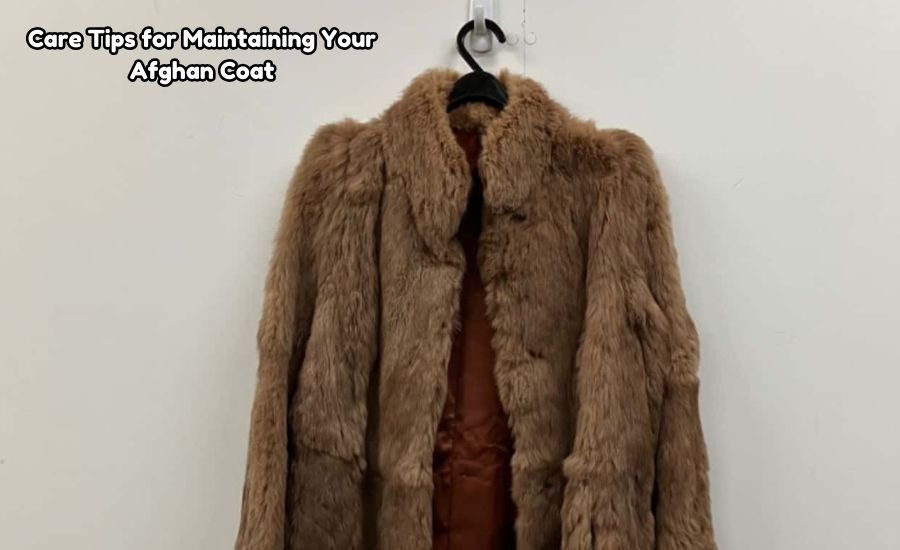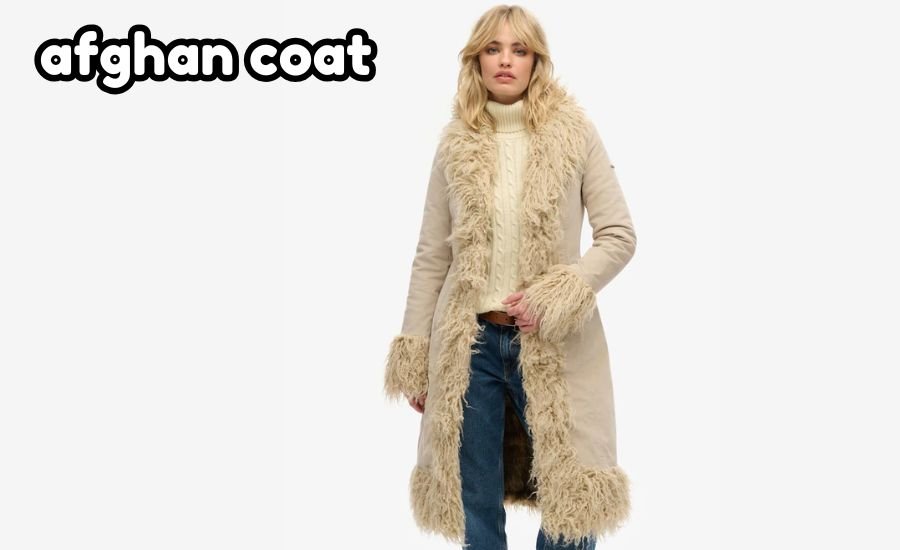Originating from Afghanistan, an afghan coat is a traditional piece of outerwear that became a global fashion icon during the 1960s and 70s. Made with hand-stitched suede and lined with soft sheepskin or faux fur, this coat blends cultural craftsmanship with unique design. Over the years, it has evolved from rural wear into a symbol of bohemian and vintage fashion, embraced by artists, musicians, and modern influencers alike.
Typically, each coat tells a story through its vibrant embroidery, mirror work, and intricate patterns. The beauty lies not just in its aesthetic appeal but also in the history and tradition stitched into every piece.Today, fashion lovers are rediscovering this classic, and it’s making a strong comeback on runways and in street fashion. Designers are blending traditional styles with new-age cuts, making it more versatile than ever.
History and Cultural Roots of the Afghan Coat
Deeply rooted in Afghan culture, the afghan coat originally served practical needs for warmth in the highlands. Local tribes used sheepskin and handcrafted stitching techniques to make these garments suitable for harsh weather. What began as utility quickly transformed into a canvas for cultural expression. These coats were often passed down from generation to generation, becoming family heirlooms that held deep meaning. Embroidery and patterns unique to different tribes added identity to each piece, making them as meaningful as they were useful.
By the 1960s, these coats had crossed borders and made their way into Western fashion scenes. They became especially popular during the hippie movement, symbolizing freedom, nonconformity, and a connection to Eastern spirituality. Rock legends like The Beatles and Jimi Hendrix often wore them during performances and public appearances. Their popularity among icons helped cement the afghan coat’s reputation as a cultural bridge between East and West. With growing global curiosity about Eastern traditions, the afghan coat became more than just clothingit became a talking point.
Key Features That Make an Afghan Coat Unique

One of the most distinctive features of the afghan coat is its craftsmanship. Artisans use real or faux suede as the exterior, combined with a thick inner lining of sheepskin or wool for warmth. This combination results in both a stylish and functional winter piece. Each seam and stitch is carefully placed by hand, showcasing the skill and patience of the maker. Decorative embroidery is another standout element, often involving bright threads, mirror work, or tribal motifs that reflect the wearer’s heritage or taste.
Unlike mass-produced jackets, each afghan coat is slightly different due to its handmade nature, which adds to its exclusivity. The attention to detail in the embroidery is a testament to the pride taken in Afghan artistry. You might find elements such as braided borders, colorful trims, or symbolic designs passed down through generations. Functional and beautiful, these coats typically come in longline cuts, mid-thigh lengths, or knee-length variations, making them versatile for different outfits. Whether worn over jeans or dresses, the afghan coat adds instant charm and cultural flair.
How to Style an Afghan Coat for Modern Looks
Adding an afghan coat to your wardrobe can instantly upgrade your outfit with a vintage twist. For casual days, pairing it with slim jeans, ankle boots, and a plain tee creates a balanced yet eye-catching look. The coat’s design does most of the styling for you. Simplicity is key to letting the coat’s intricate details stand out. On chillier days, layering it over a turtleneck and flared trousers brings a retro vibe that pays homage to the 70s. Accessories like leather belts or chunky jewelry can enhance the bohemian feel.
Since the coat already has bold details, it’s best to keep the rest of the outfit simple. You can also experiment with textures like velvet or corduroy for an added vintage touch. Combining it with soft fabrics can elevate your overall aesthetic effortlessly. Fashion-forward individuals even wear it over maxi dresses and skirts for a runway-inspired look. Whether you prefer classic or quirky, there’s always a way to make the afghan coat your own. Styling is all about confidence, and this coat helps you stand out while staying comfortable and cozy.
Popular Types and Designs of the Afghan Coat
Different types of afghan coats cater to various tastes. The most common variety is the long suede coat with full sheepskin lining and tribal embroidery. Another favorite is the cropped version, offering similar features in a more compact style. Some styles have large collars or cuffs lined with wool or faux fur, enhancing the coat’s bold look. Some versions are more ornate, with colorful threadwork, tassels, or embellishments, often worn for festivals or special occasions.
Others have a more minimalist design, focusing on neutral tones and subtle details for everyday wear. Faux-fur options are popular among those looking for cruelty-free fashion. These designs often retain the traditional charm while being animal-friendly. Designers sometimes blend traditional patterns with contemporary silhouettes, making the afghan coat suitable for modern wardrobes. Whether you go for classic or modern, these coats continue to evolve with fashion trends.
Comparison of Afghan Coat Types
| Coat Type | Length | Lining Material | Best For | Style Element |
| Classic Longline | Knee-length | Sheepskin | Cold Weather | Heavy Embroidery |
| Cropped Version | Waist-length | Faux Fur | Casual Outfits | Tribal Prints |
| Modern Minimalist | Mid-thigh | Cotton/Fleece | Everyday Wear | Neutral Colors |
| Festival Style | Variable | Faux Shearling | Events and Festivals | Bright Colors & Mirrors |
| Designer Fusion | Mid-length | Mixed Materials | Fashion Statements | Western-Eastern Blend |
Celebrities and Icons Who Wore the Afghan Coat
Fashion legends from music, film, and pop culture have all embraced the afghan coat over decades. In the 1960s, members of The Beatles famously wore them during their travels in India, helping spark global interest in the style. Jimi Hendrix was also often photographed wearing one on stage. These icons made the coat a symbol of rebellion and individuality. In more recent years, celebrities like Kate Moss, Sienna Miller, and Florence Welch have brought the afghan coat back into the spotlight.
These modern icons blend vintage with contemporary styles, proving the coat’s timeless appeal. Their influence keeps the design relevant among younger generations. Even movie stylists and costume designers are reintroducing it in period films and fashion shoots. Fashion magazines and runways showcase afghan coats as seasonal must-haves, reminding us that this piece is not just a relic but a fashion mainstay. The spotlight remains on the unique beauty and cultural richness of this iconic garment.
Care Tips for Maintaining Your Afghan Coat

Taking care of your afghan coat ensures it stays beautiful for years. Always follow the label’s cleaning instructions, especially if it’s made from real suede or wool. Most authentic coats should be dry cleaned to prevent damage. Water can stain suede or shrink wool, so professional care is highly recommended. Storing it in a cool, dry place helps preserve the fabric and prevents mildew. If your coat has embellishments like beads or mirrors, make sure to hang it properly to avoid tangling or tearing.
You can use a padded hanger to maintain its shape. Avoid plastic covers; opt for breathable garment bags. Proper storage is crucial for preserving its texture and color. Spot-cleaning minor stains with a suede brush or damp cloth also works well. Regular care adds to the life of your afghan coat while keeping it stylish and wearable season after season. With proper maintenance, it can last for decades as a treasured wardrobe piece.
Where to Buy Authentic Afghan Coats
Many online retailers and boutiques now offer handmade afghan coats imported directly from artisans in Afghanistan or surrounding regions. These stores often prioritize ethical sourcing and fair wages for craftsmen, making your purchase meaningful. Supporting these sellers helps preserve traditional art forms. Luxury fashion houses and vintage stores also stock unique pieces that blend traditional and contemporary elements.
You can find one-of-a-kind coats at thrift shops, online marketplaces like Etsy, or specialized cultural fashion retailers. Some websites even offer custom-made coats based on your measurements. Always check the product description for details on materials and origin to ensure authenticity. Buying from trusted sellers ensures you’re getting a true afghan coat that reflects its rich heritage. A genuine afghan coat is not just a purchase, but a legacy to own.
Final Thoughts on the Beauty of the Afghan Coat
Fashion comes and goes, but pieces like the afghan coat remain timeless. With its deep cultural background, handcrafted charm, and eye-catching design, it’s more than just a winter coat it’s a wearable work of art. Perfect for people who want to make a style statement without saying a word. Reviving this classic in your wardrobe brings both comfort and character.
The afghan coat is not just a trend; it’s a tribute to craftsmanship and culture that continues to inspire new generations of fashion lovers. Owning one is like carrying a piece of history with you. It’s an investment in art, tradition, and self-expression. More than fashion, it’s about connection to the past, to tradition, and to artisans who keep these crafts alive. Choosing heritage over hype ensures your fashion choices stand out and stand tall.
You Should Be Aware Of: Fringe-sweater-a-stylish-and-cozy-fashion-statement
FAQs
What is an afghan coat made of?
An afghan coat is usually made of suede or faux suede with a warm lining of sheepskin, faux fur, or fleece.
Is the afghan coat suitable for winter?
Yes, the thick inner lining makes the afghan coat perfect for keeping warm during cold winter months.
Can men and women both wear an afghan coat?
Absolutely, afghan coats are designed for all genders with various cuts and styles to suit everyone.
How do I clean an afghan coat?
Most should be dry cleaned to protect the fabric and embroidery, especially if it’s real suede or wool.
Where can I buy a real afghan coat?
You can find authentic afghan coats online, in vintage shops, or from sellers who support traditional Afghan artisans.
